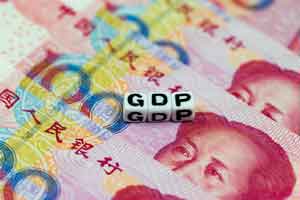Some Alternative Methods for Tracking Chinese GDP

This is the second post in a three-part series on measuring economic activity in China.
Yesterday’s blog post discussed several of the challenges in measuring Chinese gross domestic product (GDP) accurately. Today’s post focuses on some alternative methods used to try to obtain better GDP estimates, as covered in an article in The Regional Economist.
Energy Consumption
One measure examined by the authors—Assistant Vice President and Economist Michael Owyang and Senior Research Associate Hannah Shell—is the change in energy consumption. They explained that this may be a good proxy for changes in output because energy usage typically correlates with output and can be verified by outside data sources.
They cited work by economist Thomas Rawski in which he argues that Chinese GDP growth was overestimated for the 1997-2001 period, when Chinese energy consumption declined despite GDP growing at a faster pace than in the 1987-1991 period.1
“Energy consumption, however, is an imperfect proxy of economic growth. A country’s energy consumption could be impacted by several factors external to economic output,” Owyang and Shell wrote, citing factors such as increased efficiency that could lead to lower energy consumption.
Indexed GDP Proxies
The authors then discussed some broader GDP proxies that include more variables. They noted that several private-sector research firms have developed measures of Chinese GDP growth based on a wide array of indicators.
“These indexes focus on measuring the quarter-to-quarter growth rather than the level of output, but all of them suggest that there has been overstating of growth during downturns and in recent years,” Owyang and Shell wrote.
However, they said, “the problem with these measures is that a lot of them are black boxes, leaving one to wonder if they give adequate weight to the many complex facets of the Chinese economy.”
Li Index
Owyang and Shell also looked at the popular Li index, which was named after Li Keqiang, then China’s vice premier and now premier, who in 2007 said that the GDP figures are “man-made” and therefore unreliable. He suggested instead looking at electricity production, rail cargo shipments and loan disbursements.
Researchers John Fernald, Israel Malkin and Mark Spiegel created an index that estimates GDP growth based on those three variables.2 These researchers obtained a predicted value for growth from 2009 through 2012 based on the relationship between these three variables from 2000 to 2009. (For a figure showing the Li index and the official growth rate, see China’s Economic Data: An Accurate Reflection, or Just Smoke and Mirrors?)
Owyang and Shell noted that the relationship between GDP and the Li index also held during the 2009-2012 period, meaning that the changes in official GDP statistics during that period were consistent with the Li index.
“This analysis offers some validation that the quarter-to-quarter percent changes in Chinese official statistics are not overstated,” they wrote.
The authors noted that none of these methodologies would detect if the GDP level has been overestimated for a long time. The final post in this series will explore another method for estimating Chinese GDP, which uses satellite data that measure the intensity of man-made night lights.
Notes and References
1 Rawski, Thomas G. “What Is Happening to China’s GDP Statistics?” China Economic Review, Vol. 12, 2001, pp. 347-54.
2 Fernald, John; Malkin, Israel; and Spiegel, Mark. “On the Reliability of Chinese Output Figures.” FRBSF Economic Letter, No. 8, March 25, 2013.
Follow the Series
- Challenges in Measuring China’s Economic Growth
- Some Alternative Methods for Tracking Chinese GDP
- Estimating Chinese GDP Using Night-Lights Data
Additional Resources
- Regional Economist: China’s Economic Data: An Accurate Reflection, or Just Smoke and Mirrors?
- On the Economy: The New World Leader in Innovation
- On the Economy: Tigers, Tiger Cubs and Economic Growth
Citation
ldquoSome Alternative Methods for Tracking Chinese GDP,rdquo St. Louis Fed On the Economy, Sept. 12, 2017.
This blog offers commentary, analysis and data from our economists and experts. Views expressed are not necessarily those of the St. Louis Fed or Federal Reserve System.
Email Us
All other blog-related questions

